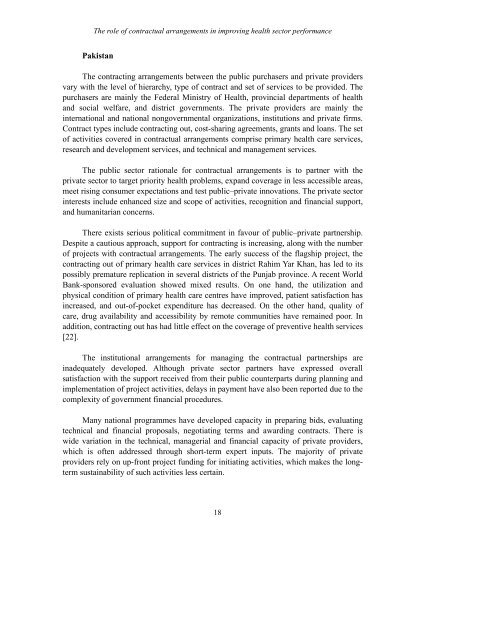The role of contractual arrangements in improving health sector ...
The role of contractual arrangements in improving health sector ...
The role of contractual arrangements in improving health sector ...
You also want an ePaper? Increase the reach of your titles
YUMPU automatically turns print PDFs into web optimized ePapers that Google loves.
<strong>The</strong> <strong>role</strong> <strong>of</strong> <strong>contractual</strong> <strong>arrangements</strong> <strong>in</strong> improv<strong>in</strong>g <strong>health</strong> <strong>sector</strong> performance<br />
Pakistan<br />
<strong>The</strong> contract<strong>in</strong>g <strong>arrangements</strong> between the public purchasers and private providers<br />
vary with the level <strong>of</strong> hierarchy, type <strong>of</strong> contract and set <strong>of</strong> services to be provided. <strong>The</strong><br />
purchasers are ma<strong>in</strong>ly the Federal M<strong>in</strong>istry <strong>of</strong> Health, prov<strong>in</strong>cial departments <strong>of</strong> <strong>health</strong><br />
and social welfare, and district governments. <strong>The</strong> private providers are ma<strong>in</strong>ly the<br />
<strong>in</strong>ternational and national nongovernmental organizations, <strong>in</strong>stitutions and private firms.<br />
Contract types <strong>in</strong>clude contract<strong>in</strong>g out, cost-shar<strong>in</strong>g agreements, grants and loans. <strong>The</strong> set<br />
<strong>of</strong> activities covered <strong>in</strong> <strong>contractual</strong> <strong>arrangements</strong> comprise primary <strong>health</strong> care services,<br />
research and development services, and technical and management services.<br />
<strong>The</strong> public <strong>sector</strong> rationale for <strong>contractual</strong> <strong>arrangements</strong> is to partner with the<br />
private <strong>sector</strong> to target priority <strong>health</strong> problems, expand coverage <strong>in</strong> less accessible areas,<br />
meet ris<strong>in</strong>g consumer expectations and test public–private <strong>in</strong>novations. <strong>The</strong> private <strong>sector</strong><br />
<strong>in</strong>terests <strong>in</strong>clude enhanced size and scope <strong>of</strong> activities, recognition and f<strong>in</strong>ancial support,<br />
and humanitarian concerns.<br />
<strong>The</strong>re exists serious political commitment <strong>in</strong> favour <strong>of</strong> public–private partnership.<br />
Despite a cautious approach, support for contract<strong>in</strong>g is <strong>in</strong>creas<strong>in</strong>g, along with the number<br />
<strong>of</strong> projects with <strong>contractual</strong> <strong>arrangements</strong>. <strong>The</strong> early success <strong>of</strong> the flagship project, the<br />
contract<strong>in</strong>g out <strong>of</strong> primary <strong>health</strong> care services <strong>in</strong> district Rahim Yar Khan, has led to its<br />
possibly premature replication <strong>in</strong> several districts <strong>of</strong> the Punjab prov<strong>in</strong>ce. A recent World<br />
Bank-sponsored evaluation showed mixed results. On one hand, the utilization and<br />
physical condition <strong>of</strong> primary <strong>health</strong> care centres have improved, patient satisfaction has<br />
<strong>in</strong>creased, and out-<strong>of</strong>-pocket expenditure has decreased. On the other hand, quality <strong>of</strong><br />
care, drug availability and accessibility by remote communities have rema<strong>in</strong>ed poor. In<br />
addition, contract<strong>in</strong>g out has had little effect on the coverage <strong>of</strong> preventive <strong>health</strong> services<br />
[22].<br />
<strong>The</strong> <strong>in</strong>stitutional <strong>arrangements</strong> for manag<strong>in</strong>g the <strong>contractual</strong> partnerships are<br />
<strong>in</strong>adequately developed. Although private <strong>sector</strong> partners have expressed overall<br />
satisfaction with the support received from their public counterparts dur<strong>in</strong>g plann<strong>in</strong>g and<br />
implementation <strong>of</strong> project activities, delays <strong>in</strong> payment have also been reported due to the<br />
complexity <strong>of</strong> government f<strong>in</strong>ancial procedures.<br />
Many national programmes have developed capacity <strong>in</strong> prepar<strong>in</strong>g bids, evaluat<strong>in</strong>g<br />
technical and f<strong>in</strong>ancial proposals, negotiat<strong>in</strong>g terms and award<strong>in</strong>g contracts. <strong>The</strong>re is<br />
wide variation <strong>in</strong> the technical, managerial and f<strong>in</strong>ancial capacity <strong>of</strong> private providers,<br />
which is <strong>of</strong>ten addressed through short-term expert <strong>in</strong>puts. <strong>The</strong> majority <strong>of</strong> private<br />
providers rely on up-front project fund<strong>in</strong>g for <strong>in</strong>itiat<strong>in</strong>g activities, which makes the longterm<br />
susta<strong>in</strong>ability <strong>of</strong> such activities less certa<strong>in</strong>.<br />
18
















